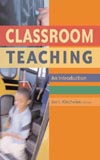Classroom Teaching - an Introduction
By Murray Bourne, 03 Oct 2005

Kincheloe, JL (Editor) ©2005, Peter Lang Publishing, NY.
Summary Review
Kincheloe's introduction is not your usual introduction for this kind of book. It is dark, brooding and cynical, especially regarding education in America. It talks of a "coup" around 1980 that changed the landscape of American education (and society) from one of healthy discussion and criticism, to one of "positivism". Positivism is the overly scientific approach to education which reduces everything to numbers ("How many passed?") and alienates everyone.
The views in this book presumably arise from the fact that many Americans feel they are under a state of siege. If they question what America is doing in the world, they are un-American and un-patriotic. If they want their students to understand why many in the Muslim world hate America or why certain facts are hidden from the American people, they are the worst subversives. The writers rightly ask - What kind of democracy is that?
Other views espoused by Kincheloe:
- Power is key to education. (p11)
- The most effective and important pedagogy today is "corporate pedagogy" - that is, we learn a lot about the world and the importance of certain goods (eg Nike) and services (eg MacDonalds) via advertising and corporate ownership of news services (eg CNN and Fox). (p14)
- We [have] become technologically proficient but ethically bankrupt. (p21)
- We should be using an 'ironic curriculum', one which is self-critical about its aims and objectives. (p20)
- We must do more to develop an historical consciousness about the development of ideas, sciences & politics (p40) (Apparently this type of thinking is frowned upon by many in US education...)
Kincheloe uses the CIA as an example of what can go wrong in the positivist vs ironic curriculum. The CIA can see the minute details, but miss the important stuff (Cuba, Iranian Revolution, fall of USSR, 9/11 [and Iraq - my addition]) (p21).
The other contributors to this book also push a self-critical, but refreshing barrow.
- Do students need "the basics" before they can think?
- Why are stimulating teachers seen as 'dangerous'?
- It is more important for students to be socially competent than to know a myriad of useless factoids
- The technology chapter by Kenneth Tobin talks of expanding the role of students into that of researchers.
- The legal chapter asks - Can schools be held liable for educational malpractice?
All in all, an interesting read. This book challenges many of our core notions. The following oft-repeated question summarises the book:
What are we doing here?
A related book review is The Game of School.
Be the first to comment below.